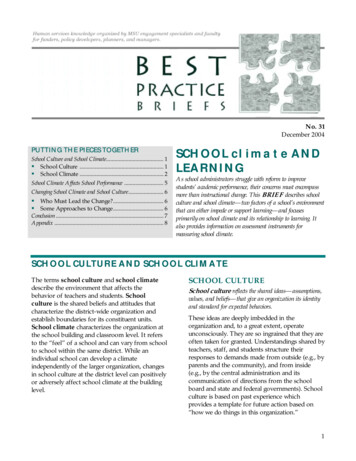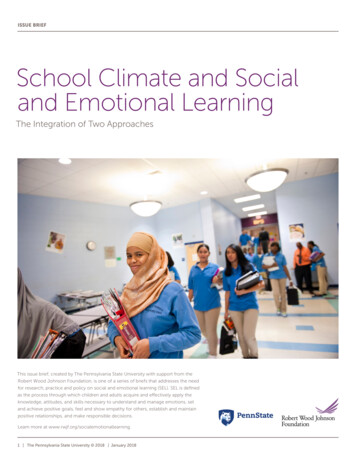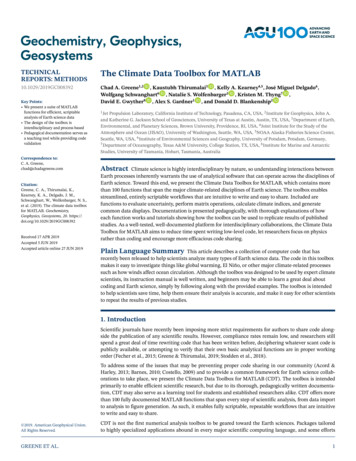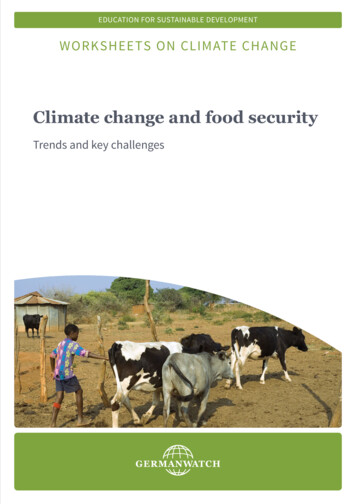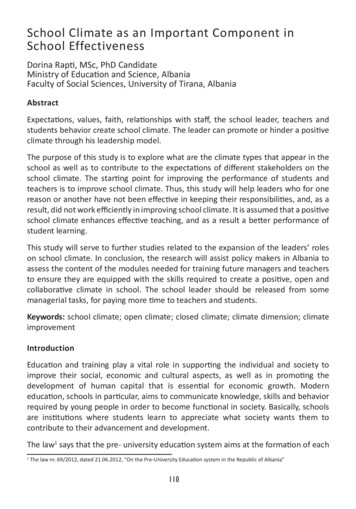
Transcription
School Climate as an Important Component inSchool EffectivenessDorina Rapti, MSc, PhD CandidateMinistry of Education and Science, AlbaniaFaculty of Social Sciences, University of Tirana, AlbaniaAbstractExpectations, values, faith, relationships with staff, the school leader, teachers andstudents behavior create school climate. The leader can promote or hinder a positiveclimate through his leadership model.The purpose of this study is to explore what are the climate types that appear in theschool as well as to contribute to the expectations of different stakeholders on theschool climate. The starting point for improving the performance of students andteachers is to improve school climate. Thus, this study will help leaders who for onereason or another have not been effective in keeping their responsibilities, and, as aresult, did not work efficiently in improving school climate. It is assumed that a positiveschool climate enhances effective teaching, and as a result a better performance ofstudent learning.This study will serve to further studies related to the expansion of the leaders’ roleson school climate. In conclusion, the research will assist policy makers in Albania toassess the content of the modules needed for training future managers and teachersto ensure they are equipped with the skills required to create a positive, open andcollaborative climate in school. The school leader should be released from somemanagerial tasks, for paying more time to teachers and students.Keywords: school climate; open climate; closed climate; climate dimension; climateimprovementIntroductionEducation and training play a vital role in supporting the individual and society toimprove their social, economic and cultural aspects, as well as in promoting thedevelopment of human capital that is essential for economic growth. Moderneducation, schools in particular, aims to communicate knowledge, skills and behaviorrequired by young people in order to become functional in society. Basically, schoolsare institutions where students learn to appreciate what society wants them tocontribute to their advancement and development.The law1 says that the pre- university education system aims at the formation of each1The law nr. 69/2012, dated 21.06.2012, "On the Pre-University Education system in the Republic of Albania"110
D. R apti - S chool C limateas an I mportantC omponentinS chool E ffectiveness111individual, in order to meet the challenges of the future, be responsible to the family,society and the nation in particular: a) to recognize, respect, protect and develop thenational identity heritage and our cultural diversity; b) to be developed in the ethical,intellectual, physical, social and aesthetic aspects, to be able to think independently,critically and creatively, to adapt to change, to have self-confidence and the spirit ofcooperation, to be ready to offer his/her assistance to the nation’s welfare, prosperity,freedom and democracy; c) to be deeply convinced that justice, peace, harmony,cooperation and respect for others are the highest human values; etc.To realize such a system, the school should be seen as a healthy place of learning,where dreams and ambitions of students and parents are the central focus, teachersare motivated to give their best, where all are respected and feel connected withschool. This is the school climate.School climate is defined as a mixture of beliefs, values and behaviors of students,teaching staff, leaders and parents, level of independence, lidership styles and jobsatisfaction. From the above definition school climate can be perceived as the prevailingatmosphere in the school, which is mainly dictated by the leaders and affects the wayhow students and teachers perceive their school and affects their values and attitudestoward school and work.Researchers on school climate, Hoy and Sabo (1998)2; Freiberg and Stein (1999)3; Hoyand Miskel (2001)4 note that a positive school climate affects the overall effectivenessof the school. In other words, it implies that there is a link between positive climate inthe school and its effectiveness. In this regard, the study of Litwin (1968)5 concludesthat it is possible to improve the climate in the school within a short period of time,intervening in lidership style. Andrew Halpin and Don Croft pioneers of research onthe school climate are of the opinion that students’ and community’s perceptionsabout the school are important to create a good climate, where teachers can have aquality teaching, students reach results according to the ambitions, and parents areinvolved in their children’s education.The study “Teachers’ job satisfaction”, in Albania, of 20116, being held for the secondtime, gives us a clear picture of the impact that pre-university education systemreforms have had in the recent four years. During this analysis various factors thataffect the performance and results of teachers as well as teachers’ attitudes in relationto these factors have been identified. Although it is accepted that, compared to 2007,2Hoy, W. K. & Miskel, C. G. 2001: Theory, Research and Practice3Freiberg, J. H & Stein, T. A. 1999: Measuring, Improving and Sustaining Healthy Learning Environments4Hoy, W. K. & Miskel, C. G. 2001: Theory, Research and Practice5Litwin, G. H. & Stringer, R. A. 1968: Motivation and Organisational ClimateTamo, A dhe Karaj, DH 2007 and 2011: The study of job satisfaction of teachers in the framework of the Excellence and Equityin Education, supported by World Bank, Investment Bank and Europian Bank6
112A cademicus - I nternational S cientific J ournalall indicators are improved, there have been several issues that present a possibilityof intervention in order to increase teacher satisfaction from work and consequentlya higher performance. Based on the above findings, it is recommended that theintervention of the education leaders to increase overall teachers’ satisfaction levelbe focused primarily in: Setting of clear criteria for assessment, appointment andpromotion of teachers based on the good work performance of everyone; Equippingschools with full teaching tools needed to guarantee the learning process.The researchers maintain that to have a more effective learning, the environment/climate should be friendly not only between students but also between teachers. Hebelieves that learning would be more enjoyable and effective if the environment wasmore friendly and hospitable than hostile.Through the examination of the relevant theories and literature, this study seeks toanswer these questions:-- What are the available kinds/types of climate in school?-- How to create a positive climate in the school?-- How can we improve school climate?The concept of school climate“The sum of the values, cultures, safety practices, organizational structures withina school, teaching practices, diversity, leader-teacher relationships, teacher-teacherrelationships, parent-teacher relationships, and student-teacher relationships, is theconcept of school climate.”School climate concept has its origins in the late 1950s as researchers in socialsciences studied variations in work environments. Andrew Halpin and Don Croftpublished in 1963 the results of their research on school climate. Thus, the conceptwas formulated, and their work became the basis of research for other researchers.Various researchers and educational reformers identified school climate in differentways, but it seems that there is a consensus on what constitutes the school climate.Freiberg and Stan (1999)7 claim that the climate of the school is the “heart and soul”of a school, the factor that motivates students, teachers and makes them to want itand willing to be there every day. Heart and soul were used as metaphorical terms tohighlight the importance of climate change, because it motivates members of a schoolmaking them feel attracted by it. In this regard, school climate is what gives life to itand highlights the values that school represents.7Freiberg, J. H & Stein, T. A. 1999: Measuring, Improving and SustainingHealthy Learning Environments
D. R apti - S chool C limateas an I mportantC omponentinS chool E ffectiveness113Hoy and Miskel (1996) 8determined that the school climate is the grouping of featuresthat distinguishes one organization from the behavior and attitudes of the people itconsists of. In other words, as the behavior of specific persons is used to distinguishindividuals from one another, the school has its own characteristics according to humaninteraction. Halpin’s (1966)9 general perception is that climate is the personality of anorganization and that the organization climate is similar to the individual personality.X school climate is different from Y school climate associated with the personality ofeach of them. Litwin and Stringer (1968)10 have argued that school climate is a facilitywith “measurable work environment parameters” based on collective perceptions ofthe people who live and work in that environment. In other words, school climate ismore or less the understanding that teachers have on the amount of kindness andhospitality they receive, while interacting with the school manager.Alexandra Loukas (2007) 11states that although it has been difficult to determine acomprehensive definition of school climate, researchers agree that climate is amultidimensional construct that includes physical, social and academic dimensions asfollows:Physical dimension includes:-- Presentation of the school building and classrooms;-- The size of the school and the students/teachers ratio in the classroom;-- The organization of classes in the school;-- The effectiveness of the tools and teaching resources;-- Security and safety.Social dimension includes:-- The quality of interpersonal relationships of all members of staff (teacher-leader;teacher-teacher; teacher-student; student-student; teacher-parents);-- A fair and equal treatment of students by teachers and other staff members;-- The degree of competition and social comparison among students;-- The extent of the contribution of students, teachers and school staff in decisionmaking process.Academic dimension includes:-- The quality of teaching;-- Teachers’ expectations for students’ achievement;Hoy, W. K. & Miskel, C. G. (1996). Educational administration: Theory, research, and practice, 5th edition. New York: McGrawHill.89Halpin, A. W. 1966. Theory and Research in Administration10Litwin, G. H. & Stringer, R. A. 1968: Motivation and Organisational Climate11Lucas, A. Vol. 5, No. 1, Fall 2007. What Is School Climate?
114A cademicus - I nternational S cientific J ournal-- Monitoring of the students progress and immediate reporting of results tostudents and parents.In fact, the climate of the school is the subject of staff and students perceptions andis measurable. From the above definitions, we can conclude that the climate of theschool has to do with the atmosphere or feeling that prevails in a particular school. Itappears from the relationship between leaders and teachers, teachers and studentsand between leaders and students. The school as a social interaction system forcesthe leaders, teachers and students to interact in the planning, decision-making andproblem solving fields in an administrative level. They also interact on personal issuesthat are part of the normal school routine.Differences between School Climate and CultureSchool climate and school culture are sometimes used interchangeably. Althoughthese two concepts are similar in some respects, they still have their differences.Both concepts identify specific aspects of the organization. In fact, the researchersthemselves say that the definitions of climate and culture are often unclear. Usuallythe difference is that culture consists of “assumptions” and ideology, and the climateis defined as the perception of behaviors. They note that the conceptual “jump” fromculture to climate is not very large, but the difference is significant and meaningful.DisciplineMethodContentLevel of abstractionClimatePsychology and Social PsychologyResearch MethodMultivariety StatisticsPerception of behaviorMultivariety StatisticsConcreteCultureAnthropology and SociologyEthnographic TechniquesLanguage AnalysisAssumptions and IdeologiesLanguage AnalysisAbstractImportance of school climateAs a starting point to this discussion it is common to refer to the climate in termsof the weather. When it is moderately warm outside we usually feel cozy andcomfortable, when it is stiflingly hot or exceedingly cold we do not feel comfortableand make a strenuous efforts to make ourselves feel better. And when it is overcast,some individuals feel relieved hoping the sun will just come out and shine throughthe clouds while others do feel challenged in their anticipation of the storm. In otherwords, the weather closely associated with the climate affects the feelings as well asour willingness to get engaged.
D. R apti - S chool C limateas an I mportantC omponentinS chool E ffectiveness115Likewise school climate affects the teachers and students’ feelings, their verywillingness to get involved, their commitment to contribute and their feelings towardsthemselves and others. The school climate does affect the teachers’ commitmentto setting out the school vision as to where the school is heading to, reflects uponthe characteristics of respect, personal dignity, honesty, fairness and safety. If theschool climate fails to mirror this set of characteristics, then integration, maintenanceof sustainability, establishment of sense of equality among students with limitedintellectual capabilities or not is questioned.According to Brooks (1999)12, students are more likely to flourish in a schoolenvironment in which they feel comfortable, when they feel they are treated fairlyby the teachers and when they feel they have a sense of belonging to the schoolenvironment. With regard to the sense of belonging it is vitally important to establisha degree of hospitality for each and every student, in order to avoid any feeling ofisolation and detachment. Factors that have a role to play in the school climate can besummarized as follows:-- Quality of interaction-- Personality of school-- Enviromental factors-- Academic performace-- Safety and school size-- Trust and respectAs often as not, the school should become a safe and positive place which assumesthe role of a facilitator in the learning process, promotes positive relationships andhelps students be better prepared to face up to the challenges ahead. The schoolclimate could have a positive impact on the student or it could easily turn itself intoan obstacle to learning. It could otherwise hinder or facilitate the academic potentialin each and every student.Even in Albania a fair share of importance has been attached to the school climate bymaking it feature considerably into the internal and external evaluation manual13. Inthis manual the school climate is portrayed as a domain which covers the physical andpsycho-social dimensions along with the learning process. The climate as such refersto the organization at the school and classroom level, it refers to the “feeling” in aschool and that one school is different from another. The manual lays the stress thickon one factor that the school climate reflects the common and shared ideas, values,vision and trust, which in turn bestow upon the school the identity and standards ofthe expected behavior. The climate is reflected upon the school atmosphere as well as12Rodney Brooks (1999), Cambrian Intelligence: The Early History of the New13National Inspectorate of pre-university education in Albania, 2011
116A cademicus - I nternational S cientific J ournalon the moral code. A pleasant physical environment promotes the social interactionand vice-versa the social interaction creates a warm and affectionate environment. Awarm and welcoming physical environment targeting learning is regarded as one ofthe most significant elements for the development of a quality education and equity.The prospects of the school climateThere are several perspectives on school climate, but within the scope of the study theperspective on ‘Climate as a personality’ will be further considered.Freiberg and Stein (1999)14 argue that although the school is not a biological organism inthe natural sense of the word, nonetheless it has the characteristics of a living organismin its organizational sense. They go on arguing that beyond the physical structure ofthe school there are other elements that do reflect the human interaction. Halpin andCroft conclude that “the climate is real: it can be felt” in the teacher-teacher, teacherstudent, student-student and teacher-principal interactions. Halpin and Croft built upthe school climate as a organizational “personality” in the process of conceptualizingthe school climate from being an open one to a closed one.The behavior of the individuals within a school does affect climate. The behaviorpatterns of various actors from that of the principal, the teachers and that of studentsand parents constitutes the school climate. Moreover, the climate prevalent in theschool, points to the interaction between principals and teachers, teachers andteachers, teachers and students as well as between parents and school. Halpin (1966)15distinguishes different types of climates that exist in schools including an open climate,controlled climate, autonomous climate, paternal climate, family climate, and closedclimate.- Open climate: Open climate of the school is chiefly associated with its expressivecharacteristics. An open climate can be easily utilized to account for both the spaceand authenticity between relationships of principals, teachers, students and parents.Hoy (1998)16 argues that the open climate reflects upon the supportive, welcomingand positive role of the principal (manager) towards teachers’ ideas as well as hisattachment and devotion to work. According to the researcher the leader showsgenuine concern over the teachers. He supports staff members; the staff are giventheir free way in undertaking tasks in the best way possible they can manage; he isparticularly careful so as not to allow the daily tasks to interfere with the responsibilitiesof teachers; in an open school climate teachers are portrayed as being tolerant, helpfuland to be revered in the profession; teachers are attentive to and ready to provide for14Freiberg, J. H & Stein, T. A. 1999: Measuring, Improving and SustainingHealthy Learning Environments15Halpin, A. W. 1966. Theory and Research in Administration16Hoy, W. K. & Sabo, D. J. 1998: Open and Healthy
D. R apti - S chool C limateas an I mportantC omponentinS chool E ffectiveness117the needs of students by working hard in order for the children to succeed in theirpursuits; teachers turn out to be reaching out, help each other at the professionallevel, including the personal one too.According to Halpin (1966), teachers work in teams to guarantee the students’ success.Teachers and leader alike make themselves available to maintain close relationshipswith students and parents. The findings indicate that the behavior enjoying the fullsupport of the school top management, the not so conspicuous top-down behavior,and the low-level stressful behavior of teachers are attributed deriving from a healthyand open organizational climate at school. The more open the school climate, themore dedicated , loyal and pleased will the teachers be. The more open the schoolclimate, the more productive students will be in their school performance.There is a broad consensus across the body of literature on school climate whichemphasizes that the open school climate pretty much favors the promotion of positiveoutcomes in students’ academic performance by contributing in turn to a good mentaland spiritual health as well as to job satisfaction of teachers and principals.According to Hoy (1998), an open school climate can not happen overnight, that shouldbe the outcome of a well-thought out development engineering and implementedbetween the teachers and school principals. That is also the outcome of robust hiringpolicies which should be characterized by good instruments of personality.- Controlled climate: The main characteristics of the controlled climate is more andmore in the way of work. Although in this case the principal is far from being themodel of dedication, importance is bestowed upon the accomplishment of tasksand little time is devoted to social life. Yet, teachers appear to be entirely devotedto their work and spend considerable chunks of time on fulfilling them. Hence, inmost cases there is little time available to allow for interaction between each other.Students are also heavily engaged with the tasks and are given little time to give overto the extracurricular activities. According to Halpin (1966)17 and Silver (1983)18 theprincipals usually keeps his distance from the teachers, students and parents in orderto avoid any degree of familiarity. Parents are not encouraged to visit the school andsee teachers about their children’s problems, using instead such a time on somethingmuch more valuable ( based on their opinion).Autonomous climate: According to Halpin (1966) the autonomous climate is a typeof climate that portrays an atmosphere where teachers have at their disposal aconsiderable degree of freedom to act in school. The leader epitomizes the modelof enthusiasm and zeal. There are no external threats or influence. Teachers have astrong desire to teach and students are motivated to learn. There is a close relationshipbetween the managers, teachers, students and parents.17Halpin, A. W. 1966. Theory and Research in Administration18Silver, P. 1983: Theoretical Perspectives on Practice and Research
118A cademicus - I nternational S cientific J ournal- Paternal climate: According to Costley and Todd (1987), 19paternal climate is describedby a type of atmosphere in which the school principal is a hard-working person, buthe falls short of having any effects on the staff; to them the label ‘hard-working” is notsuch a familiar word. There is a degree of approachability between the leaders andteachers, but teachers ‘expectations of teachers tends to be quite impractical. Theschool principal is full of life and lively, but his management style tends to lean on theautocratic side. As a result, the majority of the teachers, students and parents preferto keep their cautious distance from the leader. More often than not, students canhave a hard time expressing their concerns and difficulties, while the parents come toschool only they feel it absolutely necessary, for example, like when teachers requirethat they come.- A familiar school climate: According to Silver (1983)20 the familiar school climate isdescribed as a sort of “laissez-faire” atmosphere (let them do it). The principal is prettymuch interested in maintaining a social atmosphere that favors the fulfillment of anyparticular task. Thus, a significant number of teachers is not committed to their maintask. Some of them do not take a liking to the way how a principal leads, but others donot necessarily share the same opinion with their colleagues or with the principal. As aresult, those that are not really dedicated, make up a particular group since they exhibitthe same type of behavior. Most of the students do not take their learning processseriously and some others do cook up all sorts of vain and hollow excuses to be out ofschool or to be absent from it (unexcused absences). Most parents are not involved intheir children’s education, and they are clueless as to what their children are up to atschool. They think that it is not necessary for them to attend meetings that are meantfor parents. According to Halpin (1966)21 in this type of familiar climate between theprincipal and the teachers a scant attention is paid to the overall performance of theschool.- Closed climate: Hoy and Sabo (1998)22 argue that the closed climate represents theopposite to the open climate. The key characteristics of a closed climate has beenidentified by Halpin (1966) and that one is primarily concerned with the lack ofcommitment and productivity. There is hardly any commitment particularly on thepart of both the principal and teachers. There is hardly any emphasis on fulfillmentof duties; while the director is engaged in routine activities or trivial matters or in anunnecessary paperwork that teachers respond to with a minimum degree. The schoolprincipal tends to be stern and wielding control. He inattentive, not supportive, andnot on hand. As a result, most of the teachers tend to be frustrated and ineffective.According to Sabo (1998), there is a lack of respect on the part of the principals. In19Costley, Dan L. & Todd, Ralph , 1987, Human relations in organizations20Silver, P. 1983: Theoretical Perspectives on Practice and Research21Halpin, A. W. 1966. Theory and Research in Administration22Hoy, W. K. & Sabo, D. J. 1998: Open and Healthy
D. R apti - S chool C limateas an I mportantC omponentinS chool E ffectiveness119addition to this, teachers do show a lack of respect towards the school authority(management), towards each other or even to the students. Teachers are intolerantand divided, hence a social pressure takes hold at school. Hoy (1998) sets down thesame features as those of a closed unhealthy climate / like the ones already listed byHalpin. Under such an atmosphere, it would be contrary to reason to expect studentsto have any good academic achievement or to show any positive attitudes towardsschool and to one-another simply because there is no example set to be followed.Creating a positive school climateA positive school climate is often characterized by: a strong relationship betweenstudents and staff; the formal discipline administered is not punitive by any measure,but agreeable to the consequences; engagement, assessment and managershipopportunities for students in a wide range of activities. In a number of surveysconducted by Johnsons’ (1993)23, Freiberg (1999)24; Kuperminc &Leadbeater & Blatt(2001)25 a total of eight factors have been determined in relation to a positive climatein the school which is associated with positive educational and psychological outcomesfor the students and school staff as shown in the chart 1:Chart 126 Seven factors of a positive climate in the school23Johnson, David W. & Johnson Roger T. 1993, Social Interdependence Theory and Cooperative Learning24Freiberg, H. J. 1999. Introduction, in School Climate: Measuring, Improving and Sustaining Healthy Learning EnvironmentsKuperminc, G.P., Leadbeater, B.J., & Blatt, S.J. (2001). School social climate and individual differences in vulnerability topsychopathology among middle school students.2526Positive school climate http://www.edu.gov.mb.ca/k12/specedu/beh/pdf/3.pdf
120A cademicus - I nternational S cientific J ournalFreiberg and Stein (1999)27 argue that the school climate can be seen in every otheraspect: from the way how teachers behave, the data over students’ participation inthe class, in the course of the implementation of the programs, during the holidays,in the teachers’ common room, from the movements of students down the hall andfrom their communication patterns etc. Interestingly enough, school climate does notexist in a random way. School climate is established as such can be maintained. It isthreatened to fall apart only if there is a shift in the school life. The above researchersarrive at the conclusion that it is quite true that the behavior of headmasters, teachers,students and parents affects school climate and to a certain extent it is the managerhimself who sets up the climate, that is, he is the one capable of determining whetherthe climate will be a positive or negative one.In order to set up a positive climate, the school focuses upon some areas. It getsinvolved in series of initiatives as outlined in the diagram of “Development of healthyand respectful relationships among members of the school community” which aredepicted in the chart 2:Chart 228 Development of healthy and respectful relationships among members ofthe school communitySeveral guiding principles concerning the implementation of these initiatives:-- Everyone has a role to play in building up a welcoming, positive and inclusiveclimate at the school. The success depends heavily on the active involvementof principals, staff members, students, parents and other community memberswho engage together behind a vision, which is well-planned and supportive tothe community;27Freiberg, J. H & Stein, T. A. 1999: Measuring, Improving and Sustaining Healthy Learning Environments28Promoting a pozitive school climate df
D. R apti - S chool C limateas an I mportantC omponentinS chool E ffectiveness121-- The building of a positive school climate requires that the focus is narroweddown on the development of a robust relationship and respectful of the wholeschool community - among students, adults and between adults and students.-- Building a positive school climate means entrenching the principles of equalityand inclusion in all aspects of the learning environment in order to support thewell-being and academic achievement of all students.-- No single solution can be prescribed to guarantee the establishment andmaintenance of a positive school climate. Success requires an ongoing effortto be made which should be comprehensive and cooperative from all of thestakeholders with interests in the school.According to these researchers, it is argued that the school climate can be easilymanipulated and thus directly influence the behavior of people associated with theschool. They point out that the key criteria to the establishment of a positive climatein the school are : a) job satisfaction, b) recognition of the human dignity as well asteamwork.29Improvement and maintenance o
D. Rapti - School climate aS an impoRtant component in School effectiveneSS 111 individual, in order to meet the challenges of the future, be responsible to the family, society and the nation in particular: a) to recognize, respect, protect and develop the national identity heritage and o
